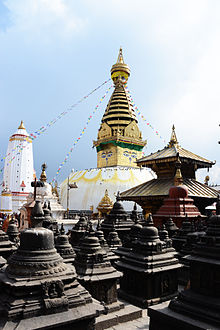Top ten dangerous airports in the world
Top 10 Most Dangerous Airports in the World

In terms of traveling long
distances, flying on an airplane is the fastest and easiest way to get
to your destination. The only problem is that flat stretches of runway
aren't always available in certain places. This means that pilots have
to be particularly skilled to land on a runway that juts out from a mountain or one that appears in a narrow valley. Here are 10 of the most dangerous airports in the world to land at.
10. Lukla Airport in Nepal

[Image Source: Wikimedia]
The Lukla Airport in Nepal serves
as the main airport for those visiting Mt. Everest. Part of what makes
this airport so difficult to land in is how it is nestled in between
mountains and the incredibly short length of runway. There are no lights
and little electric power, so landing in anything other than perfect
conditions becomes even riskier. There are also no air traffic
controllers on site, so pilots are on their own to touch down in
sometimes large aircraft.
9. Courchevel International Airport in France
https://www.youtube.com/watch?v=XF2uS9WdxrY
Video of a landing at the Courchevel airport went viral last year as it has the shortest runway of any airport at 525 meters. Not only this but the paved runway has a downward gradient of 18.5%
which makes taking off even more difficult. To add on top of the
already difficult landing, the runway is built right into the Alps where
pilots have to fly through a narrow valley even to prepare for descent.
If aircraft do not gain enough speed by the end of the runway, they
simply fly off the edge of a cliff, hoping for the best.
8. Toncontin Airport, Tegucigalpa, Honduras
https://www.youtube.com/watch?v=v_z5HtME9n8
As you may be noticing, airports in mountains become very
hard to land at due to the variant terrain and often short approaches.
Toncontin Airport is no different. In order for planes to prepare for
descent, they must make a quick 45-degree bank turn to reach the runway
in a valley. After this bank, planes must rapidly drop in altitude,
being careful not to scrape the terrain directly underneath.
7. Princess Juliana International Airport in St. Maarten

[Image Source: Wikimedia]
Princess Juliana Airport is perhaps the most famous on the
list, most notable for the public beach situated just before the runway.
This placement often results in large and loud gusts of wind and sand
to those enjoying the crystal blue water. For the pilots, hitting
visitors is the least of their worries. The runway is only 2,179 meters long,
which is very short considering the large aircraft that land here
require more than 2,500 meters to ensure a safe landing. Princess
Juliana was initially built for smaller planes, but the booming tourist
industry has brought A340s and 747s into the regular traffic rotation.
6. Paro Airport in Bhutan, Himalayan Mountains
https://www.youtube.com/watch?v=zXWTqufiu50
Continuously ranked as one of the most dangerous airports in the world, only 8 pilots
are qualified to land on this airstrip. The runway is surrounded by
5,500-meter peaks with a runway only 1981 meters long. Due to the fast
descent that large planes need to make to approach the strip, many rank
it as the most dangerous airport in the world.
5. Gibraltar International

[Image Source: Wikimedia]
While this runway isn't particularly hard to land at, an
interesting design feature makes it incredibly dangerous. The main
street in the area, Winston Churchill Avenue, intersects the runway and
has to be closed when a plane needs to land. There is a stoplight on the
road telling cars to stop, but there have been a number of close calls
in the airport's history.
4. McMurdo Air Station, Antarctica
 [Image Source: Wikimedia]
[Image Source: Wikimedia]
Not many people travel to Antartica, which means that the
airport infrastructure there is significantly lacking. This runway isn't
particularly short, but it is made of slick ice which can cause planes
to run askew if the landing isn't perfect. Temperatures here are below
freezing on average the entire year. In 1970 there as a bad crash of a
C-121 that still sits off to the side buried in snow. Many months out of
the year it is dark continuously, and due to the lack of lights, pilots
are trained to land using night vision goggles.
3. Madeira Airport

[Image Source: Wikimedia]
Madeira Airport is one of the few in the world where
engineers build a runway platform in order to expand. The landing strip
sits between steep cliffs and the shores of the ocean. When an expansion
project was planned, designers saw that the only option was to build a
series of platforms on an artificial island extending from the current
runway. Over 180 columns hold the runway up which have to withstand
serious shock loading during landings.
2. MCAS Futenma, Okinawa
https://www.youtube.com/watch?v=adz3jyzQlgg
This airport is situated in a US Marine Corps Air Station in Okinawa,
Japan. The Navy and the Marine Corps rank it as the most dangerous
airport in the world where F/A-18 Hornets and V-22 Osprey continuously
land. The area is strategically important to the US military, which is
part of the reason it maintains operation. Part of the reason this
airport is so dangerous is because high-density housing sits in an area
that should be cleared for emergency situations.
1. Narsarsuaq Airport, Greenland

[Image Source: Wikimedia]
Similar to Antartica, the
airports in cold Greenland are constantly covered in ice. At only 1,800
meters and canvassed in slick ice, this runway is the most difficult in
the world. The weather is constantly stormy creating intense turbulence
and low visibility on approach. Shear winds affect planes which, coupled
with the icy runway, can direct them off course. The nearby active
volcano also commonly erupts sending ash into the clouds which can stall
and destroy engines.
https://www.youtube.com/watch?v=gPGc3CKxDHk






































